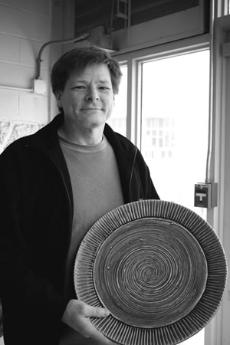Functional Wares

Pishkur shows one of his ceramic plates. He created the swirl using a technique he learned in Korea.
As a junior in high school, Frank Pishkur, head of the art department, took an art class that began his career.
“I took a class in high school my junior year because I thought it would be easy for me and it was easy for me because I was able to get self-involved in the work,” he said. “I would do that homework but I wouldn’t do the math homework or Spanish homework so much.
“After six weeks, they pushed me out of the beginners class to the intermediate class.”
Several degrees, exhibitions and world travels later, Pishkur has come to Joplin, Missouri. His newest exhibition will be held at the Post Memorial Art Reference Library in the Joplin Public Library through the month of March.
The exhibit will focus mostly on functional wares, pieces of art that have a use in everyday life, such as a cup or a plate. Other types of art are sculptural forms, which are completely for aesthetic purposes.
“Most of the things I make have a dual purpose,” he said. “They have an aesthetic function and they have a possible usage, though it’s not a perfect usage.”
Even though he makes specific pieces of art, they are often used in ways other than originally intended, but it doesn’t seem to bother Pishkur at all.
“If you go to WalMart and buy a coffee cup, you are only going to use it for coffee,” Pishkur said. “With my work, sometimes it is used in a bit of a different way than I intended, but it will serve a purpose.
“Some of the things I make are tall cups for beer and such, but sometimes the tall cups are used for vases rather than drinking out of. Ideally I am not making it so much for the function as the actual visual presentation.”
Another reason that the unique use of his vessels doesn’t bother him is because, historically, the use of the art changes.
“We never know what the future is going to do with that actual object,” Pishkur said. “A couple hundred years ago in Europe, tulips were a valuable commodity. There are these elaborate ceramic forms made specifically for showing off tulips. Now, tulips are no longer a very expensive commodity item.
“A lot of the art made through the Middle Ages and Renaissance were based off of religious ideas or education. They made paintings for people to understand the gospel. Now days we have the printing press and people can read the Bible for themselves. Now we appreciate those original paintings more on an aesthetic level rather than for educational purposes.”
The Post Memorial Art Reference Library opens at 9:30 a.m. Monday through Saturday and 1 p.m. on Sundays.
Pishkur’s art and biography can be seen at frankpishkur.com.
Your donation will support the student journalists of Missouri Southern State University. Your contribution will allow us to purchase equipment and cover our annual website hosting costs.















